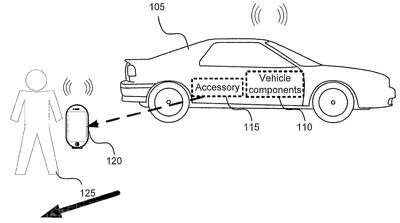In June, Apple filed a new patent application [PDF] with the European Patent Office describing a system using an in-car accessory with an iOS device to set up geofences to activate various vehicle functions as a user approaches a vehicle.
According to the 15-claim application, which specifically describes "Accessory control with geo-fencing", the accessory (which may or may not be built-in to the car itself) would transmit a signal to a linked mobile device, allowing the device to monitor the location of a vehicle. When the mobile device (and the user) are close enough to the car, the mobile device would transmit a second signal to the accessory within the car, allowing it to trigger functions like door unlocking, defrosting, heating, trunk opening, seat warming, and more.

The first signal can identify a current or future location of the vehicle. The mobile phone can generate one or more virtual geofences based at least in part on the location of the vehicle as determined from the first signal. For example, a geofence can be defined as a circular boundary centered on the vehicle's location, the radius being equal to a pre-defined distance. The mobile phone can repeatedly estimate its own location.
Upon detecting that the mobile phone has crossed a geofence (e.g., generally or in a particular direction), the mobile phone can generate and transmit a second signal to the vehicle. The accessory can control or coordinate control of one or more vehicle functions in response to receipt of the second signal.
Apple notes that geofences can be made in shapes that parallel vehicle components for very specific in-app functions. For example, a geofence could be tied specifically to a trunk or a door, with the mobile device able to identify the absolute-location boundaries of each individual geofence. With such accurate geofencing, a car's trunk could be opened as a user approaches, for groceries or bags to be put away, while the car doors stay locked until later approached.
Geofences can also function on time, with features like a car's heating system able to be activated when a mobile device estimates that an owner is "five minutes away and approaching the vehicle."
Like Apple's iBeacons, which are designed to transmit specific location information to mobile devices, Apple's vehicle accessory system would potentially send signals over Bluetooth LE to activate various functions within the car. Apple suggests Wi-Fi and cellular hardware could also be included in order for the accessory to communicate with mobile devices when owners are located far from their cars.
Along with serving as a possible expansion of the use of Apple's iBeacon technology, the geofencing system described in the patent could also be a future expansion of Apple's iOS in the Car initiative, which is designed to provide enhanced iOS integration in automobiles.
The first hints of iOS in the Car have been bundled into the new 2014 Honda Civic, allowing users to access HondaLink apps for iOS to connect to an iPhone 5 or later. Apple's ultimate goal for iOS in the Car is far more advanced, however, with iOS built-in to in-dash systems.
The patent, which was filed in June and published in November, lists former Apple employee Sylvain Louboutin as an inventor.
Update: The original U.S. patent application from June 2012 has now been published.






















